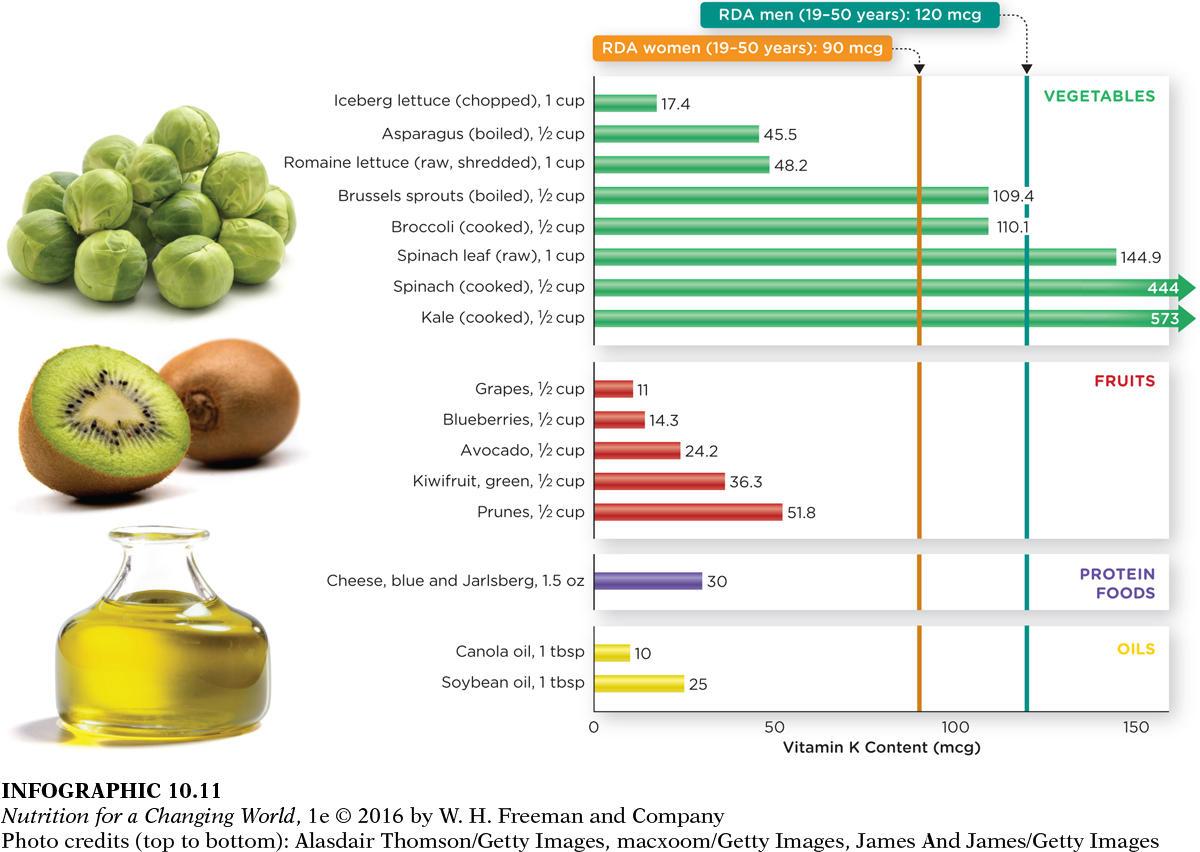VITAMIN K
Another fat-soluble vitamin is vitamin K, an essential nutrient that’s found in food. However, a significant amount of our daily requirement of vitamin K may be produced by bacteria in the intestine. The most significant dietary sources of vitamin K are green leafy vegetables; some cheeses, fruits, and vegetable oils are also good sources. The requirements for vitamin K are given in Adequate Intake (AI) amounts since current knowledge does not provide sufficient evidence to establish a specific RDA. The AI for men 19 years and older is 120 mcg and for women in the same age range the AI is set at 90 mcg. (INFOGRAPHIC 10.11)
INFOGRAPHIC 10.11 Dietary Sources of Vitamin K It is found most abundantly in green leafy vegetables.

Question
10.10
 What leafy green vegetables do you regularly consume that are high in vitamin K?
What leafy green vegetables do you regularly consume that are high in vitamin K?
Kale, spinach, and romaine lettuce are great sources of vitamin K.
Functions of vitamin K in the body
Vitamin K is required to complete the synthesis of several proteins in blood that cause the blood to clot when those proteins are activated. The vitamin also plays a key role in bone metabolism by modifying bone proteins, which allows them to bind calcium and regulate bone formation. Although studies suggest that a diet high in vitamin K is associated with lower risk of hip fractures in aging adults, current evidence is insufficient to recommend supplementation for the prevention of osteoporosis or fractures.

All babies are born with low levels of vitamin K. Babies generally have enough vitamin K stores to stop bleeding. However, one in 10,000 babies experience vitamin K deficiency bleeding. These babies don’t have enough vitamin K to make their blood clot. For this reason, doctors recommend that all babies receive vitamin K at birth.
BSIP/UIG/Getty Images
Vitamin K deficiency and toxicity
Given its key role in blood clotting, vitamin K deficiency can cause uncontrolled bleeding, or hemorrhaging. This can result from long-term use of antibiotics that destroy intestinal bacterial, or the use of medications that prevent clotting (anti-coagulants) and interfere with the metabolism of vitamin K. Since the early 1960s, newborn babies have received a dose of vitamin K at birth to reduce the risk of hemorrhage because they have limited liver stores of vitamin K and relatively “sterile” intestines.
Toxicity is rare and there is no established UL for vitamin K, but individuals who are prescribed anti-coagulate drugs must strive to keep vitamin K intake at consistent levels from day to day as the vitamin will interfere with those medications.

Sun protection is essential to skin cancer prevention. Ninety percent of non-melanoma skin cancers and 65% of melanomas are associated with exposure to UV radiation from the sun. For this reason, the American Association of Dermatology recommends getting your vitamin D from food to minimize the risk of skin cancer.
Oleg Mikhaylov/Shutterstock
Over the years, Holick hasn’t just treated one lowland gorilla—he’s administered supplemental vitamin D to twin polar bears who could no longer walk, and revived ailing Komodo dragons at the National Zoo. And his work is hardly restricted to animals—he’s treated innumerable people whose health problems he believed stemmed from vitamin D deficiencies.
But it’s important to not take concerns over vitamin D deficiency too far, cautions Clifford Rosen, MD, who helped the Institute of Medicine establish the latest DRIs for vitamin D. Vitamin D deficiencies were more of a concern 20 years ago, before people became aware of the vitamin’s importance and started adding it to foods, he says. Although millions of Americans still have slightly low levels of vitamin D, that doesn’t mean they are at risk of bone weaknesses and other problems, says Rosen. “Most of these people are healthy people, with slightly low vitamin D levels.” A diet that meets the DRI of 600 IU per day guarantees that “virtually everybody” gets enough of the fat-soluble vitamin, he says.

Healthy people who consume foods fortified with vitamin D and dairy products do not need vitamin D supplements.
Blend Images/Alamy
Instead, what concerns Rosen is the emphasis on supplementation, which can put people at risk of problems from too much vitamin D. Rosen, Director of Clinical and Translational Research and a Senior Scientist at Maine Medical Center’s Research Institute in Scarborough, recently treated a patient with symptoms of hypervitaminosis D, causing her blood calcium levels to spike. “We just lowered her vitamin D and she was fine.” He even sees people who take supplements that contain 5,000 IUs to 10,000 IUs. “That’s an issue.” And there may be little benefits that offset the risks of supplements—a recent review found that taking supplements doesn’t decrease the risk of cancer and other health problems linked to low vitamin D.
People who are otherwise healthy don’t need to take supplements of vitamin D, says Rosen—simply eat dairy products, get some exercise, and step outdoors occasionally to get a bit of sun. “That should do it.” However, the American Association of Dermatology, in its statement on vitamin D, urges Americans to stay out of the sun, because of risk of skin cancers. “Getting vitamin D from a healthy diet, which includes naturally enriched vitamin D foods, fortified foods and beverages, and/or vitamin supplements, and practicing sun protection offer a healthier and safer alternative.”

 What leafy green vegetables do you regularly consume that are high in vitamin K?
What leafy green vegetables do you regularly consume that are high in vitamin K?

